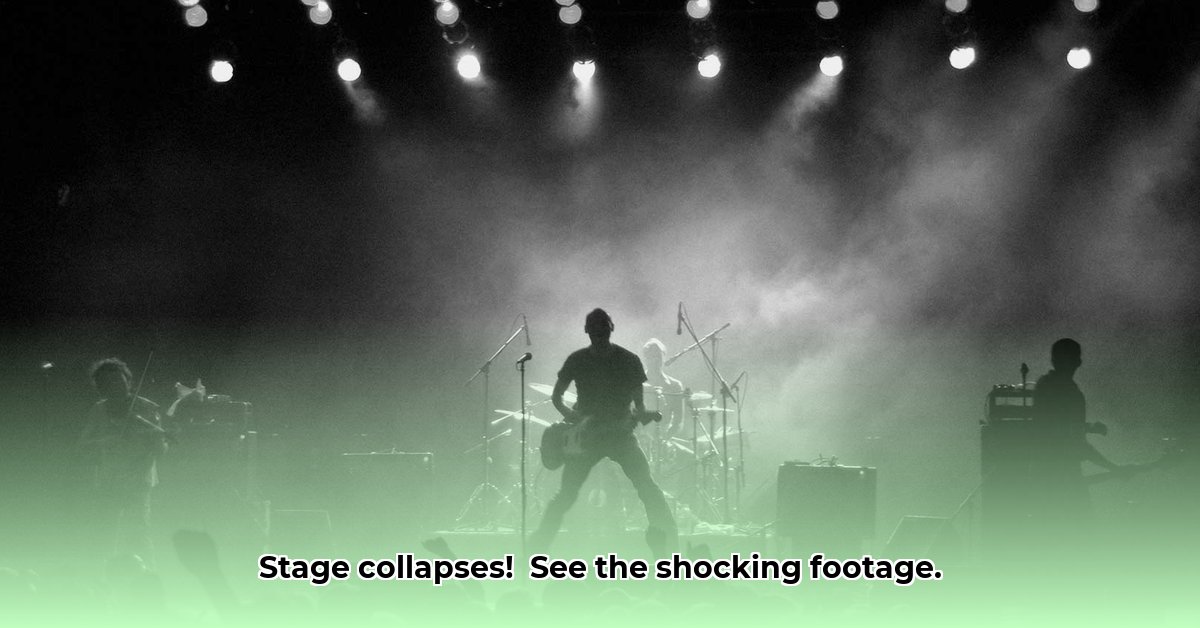Ever wondered what happens when rock gods meet gravity? It’s not always pretty! This isn’t just about embarrassing YouTube clips; we’re diving deep into the world of rock star stage falls – the funny, the scary, and the ones that taught everyone a lesson. We’ll look at some of the most memorable wipeouts in rock history, figuring out what went wrong and how these mishaps could have been avoided. For similar incidents in country music, see this [country star’s fall](https://braghq.com/country-music-star-walks-off-stage). Think of it as a backstage pass to the sometimes-chaotic world of live music, complete with tips and tricks to keep everyone safe and sound (and upright!). So grab your favorite band tee, and let’s get started!
Rock Star Falls Off Stage: Epic Fails & Safety Lessons
A Hilarious, Yet Harrowing, History of Rock Star Stage Falls
Let’s be honest: Seeing a rock star take a tumble onstage is both shocking and strangely captivating. It’s become a part of rock ‘n’ roll mythology, right up there with legendary guitar solos and rebellious anthems. But these falls aren’t just good for a laugh; they’re a stark reminder of the potential dangers lurking beneath the dazzling lights and roaring crowds. We’re diving deep into the world of on-stage stumbles, exploring what causes these gravity-defying moments, and most importantly, what we can learn to keep our musical heroes safe and sound.
Top 15 Memorable Stage Plummets: When Gravity Won
Here are fifteen unforgettable examples that highlight the wild variety of reasons why even the most seasoned performers sometimes end up on the floor:
-
Axl Rose (Guns N’ Roses): This iconic frontman’s high-octane performances have, unfortunately, been punctuated by several leg injuries due to falls. In 2010, during a Guns N’ Roses show in Colombia, Rose skidded on stage while trying to get closer to the audience, landing hard but maintaining his composure. His dedication to the show, despite the pain, is truly legendary.
-
Dave Grohl (Foo Fighters): Known for his energetic stage dives and all-around crazy showmanship, Grohl’s had his fair share of spills, famously even breaking his leg mid-concert in Gothenburg, Sweden, in 2015. Despite the injury, he returned to finish the show, later performing on a custom-made throne. The man’s commitment to the music is simply unmatched.
-
Iggy Pop: The undisputed Godfather of Punk, Iggy Pop is famous for his intensely physical performances. His falls are often less accidents and more part of the show’s chaotic energy – a deliberate embrace of the unpredictable, often fueled by his raw, unbridled performance style.
-
Pete Townshend (The Who): The legendary windmill guitar strums of Townshend have occasionally ended with a less-than-graceful landing. His energetic playing style sometimes overtakes him, leading to tumbles that become part of The Who’s iconic stage presence.
-
Steven Tyler (Aerosmith): Tyler’s flamboyant stage antics and daredevil moves have often resulted in spectacular, slightly painful tumbles. In 2009, he fell off stage at a show in South Dakota, suffering head and neck injuries. We’re talking full-on, gravity-defying falls that somehow only add to his rock god status.
-
Henry Rollins (Black Flag): Known for his hyper-intense performances, Rollins’ shows often look more like a wrestling match. The energy is palpable, and sometimes that leads to a dramatic fall, adding to the raw, visceral experience of a Black Flag show.
-
Mick Jagger (The Rolling Stones): Even rock royalty isn’t immune! Jagger’s decades-long career has seen a few memorable stumbles, proving that age and experience don’t always prevent a little slip-up. His ability to recover with grace only enhances his legendary status.
-
Mike McCready (Pearl Jam): This guitarist’s recent fall during a show in Vancouver is a great example of how quickly things can go wrong. A sudden stumble during a guitar solo reminds us that even seasoned professionals can lose their footing, but McCready continued to play his solo even while on the ground.
-
Ozzy Osbourne: The Prince of Darkness himself has taken a few tumbles over his long career. These falls, often coupled with some of his more…unconventional stage antics, have always added to his unique persona, solidifying his image as an unpredictable rock icon.
-
Robert Plant (Led Zeppelin): Even Led Zeppelin, masters of rock, weren’t immune to the occasional stage fall, proving even the most legendary acts can be caught off guard, reminding us of the human element behind the myth.
-
Bono (U2): Bono’s eagerness to connect with his audience has led to several falls over the years. In his attempt to get closer to fans, he has toppled off the stage on more than one occasion.
-
Madonna: During a performance at the 2015 Brit Awards, Madonna fell when her cape, which was supposed to detach, got stuck and pulled her down the stairs. She recovered and finished her performance like a true professional.
-
Katy Perry: In 2008, while performing “I Kissed A Girl” at the MTV Latin America Awards, Katy Perry slipped and fell on a frosting-covered stage. She fell multiple times as she tried to get up, turning the mishap into a comical moment.
-
Carlos Santana: In July 2022, guitarist Carlos Santana collapsed onstage during a concert in Michigan due to heat exhaustion and dehydration, highlighting the physical demands on performers.
-
Eddie Vedder (Pearl Jam): While not a fall off the stage, Vedder has been known for his intense performances that sometimes involve tumbles and near-falls on the stage, showcasing his raw energy and commitment.
Unraveling the Mystery: Why Do Rock Stars Fall Off Stage?
So, what leads to these epic fails? The causes are surprisingly diverse and often involve a combination of factors:
-
Dim Lighting: Poor stage lighting can easily obscure tripping hazards like cables, equipment, or even uneven flooring. Imagine trying to navigate a dark stage in the middle of a high-energy performance! Insufficient lighting creates shadows and makes it difficult for performers to see potential obstacles.
-
Stage Clutter: A chaotic jumble of instruments, cables, monitors, and other equipment can easily become a tripping hazard, turning a high-energy show into a sudden fall. Poor cable management is a common culprit.
-
Stage Design Defects: Poorly designed stages with uneven surfaces, poorly placed steps, or unsafe ramps create a high-risk environment for performers already moving at a high speed. Lack of guardrails or poorly marked edges can also contribute to falls.
-
Costume Chaos: Long skirts, loose clothing, or even something as simple as high heels can prove to be a recipe for disaster when combined with dynamic stage movement. Restrictive or cumbersome costumes can limit mobility and increase the risk of tripping.
-
Exhaustion: Performing for hours on end, often with little time to rest or hydrate, can take its toll on a musician’s energy levels, reflexes, and balance. Fatigue is a serious issue that can easily lead to falls and other performance-related incidents.
-
Audience Interaction: Overzealous fans jumping onto the stage or reaching out to their idols can cause unexpected disruptions and create dangerous situations. Uncontrolled audience behavior can create a chaotic and unpredictable environment for performers.
-
Substance Use: While not always a factor, the use of alcohol or drugs can impair judgment and coordination, significantly increasing the risk of falls and other accidents on stage.
Preventing the Plunge: Safety First!
Preventing these falls requires a multi-faceted approach involving musicians, stage crews, and venue management:
For Musicians:
-
Rehearse, Rehearse, Rehearse: A thorough understanding of the stage layout and equipment placement is essential. Practice navigating the stage in different lighting conditions to anticipate potential hazards.
-
Pre-Show Checks: Before hitting the stage, a quick visual inspection for potential hazards is always a good idea. Identify any potential tripping hazards and communicate them to the stage crew.
-
Sensible Footwear: Comfortable shoes that provide good traction are critical, especially on potentially slick surfaces. Avoid wearing high heels or shoes with slippery soles.
-
Stay Hydrated & Rested: Adequate rest and hydration are crucial for maintaining energy levels and alertness. Avoid alcohol and other substances that can impair judgment and coordination.
-
Communicate with the Crew: Maintain open communication with the stage crew regarding any safety concerns or potential hazards.
For Stage Crews:
-
Regular Equipment Inspections: Regular checks for loose wires, faulty equipment, and other potential hazards are vital. Ensure all equipment is properly secured and in good working order.
-
Improved Stage Lighting: Adequate lighting is non-negotiable for safety. We’re talking bright, evenly distributed lighting to eliminate any dark spots. Work with lighting designers to create a safe and visually appealing environment.
-
Safe Equipment Placement: Careful placement of instruments, cables, monitors, and other equipment is key to maintaining pathways free of tripping hazards. Use cable ramps or ties to keep cables out of the way.
4.
- Free Songwriting Competition Opens Doors for Aspiring Musicians - December 16, 2025
- Lyrics Competition Offers Prizes And Valuable Industry Feedback - December 15, 2025
- Major Lyric Contest Opens Doors for Aspiring Songwriters - December 14, 2025










